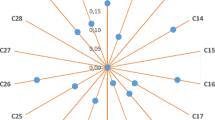Abstract
Continuing previous researches on engineering education, this paper presents how to build and use a professional training simulator. The training simulator is specified and then, it is implemented as a set consisting of a technical simulator, basic concepts and techniques and a basis for professional regulation documents. An example of usage shows that, through the construction of the training simulator, the individual performance of student work increases significantly, professional skills are acquired in an integrated way and cooperation between students becomes a permanent practice. In conclusion, recommendations are being made to extend professional simulators to a larger coverage of professional skills. This extension will be at the expense of accumulation of theoretical knowledge with a potential and probable future application.
Access this chapter
Tax calculation will be finalised at checkout
Purchases are for personal use only
Similar content being viewed by others
References
Board, M.: Control algorithm modeling guidelines using MATLAB, Simulink, and Stateflow. V2.0. Technical report, The Mathworks, Inc. (2007)
Dozortsev, V.: Development of computer-based training simulator for industrial operators: main participants, their roles and communications. Autom. Remote Control 71(7), 1476–1480 (2010)
Gordon, J., Oriol, N., Cooper, J.: Bringing good teaching cases “to life”: a simulator-based medical education service. Acad. Med. 79(1), 23–27 (2004)
Isoc, D., Isoc, T.: Practice of peer-review and the innovative engineering school. In: 2015 9th International Symposium on Advanced Topics in Electrical Engineering (ATEE), Bucharest, Romania (2015)
Joe, R., Otto, A., Borycki, E.: Designing an electronic medical case simulator for health professional education. Knowl. Manag. E-Learn. Int. J. 3(1), 63–71 (2011)
Lazăr, C., Vrabie, D., Carari, S.: control systems using PID controllers. Matrixrom, Bucharest (2004). (In Romanian)
McGrattan, K., Hostikka, S., Floyd, J., Baum, H., Rehm, R., Mell, W., McDermott, R.: Fire Dynamics Simulator (Version 5) Technical Reference Guide. NIST Special Publication, Gaithersburg (2004)
Reinhardt, E., Crookston, N.: The fire and fuels extension to the forest vegetation simulator. General Technical report RMRS-GTR-116, Ogden (2003). (Technical Editors)
Rogalski, T., Tomczyk, A., Kopecki, G.: Flight simulator as a tool for flight control system synthesis and handling qualities research. Solid State Phenom. 147, 231–236 (2009)
Scalese, R., Issenberg, S.: Effective use of simulations for the teaching and acquisition of veterinary professional and clinical skills. J. Vet. Med. Educ. 32(4), 461–467 (1982)
Author information
Authors and Affiliations
Corresponding author
Editor information
Editors and Affiliations
Rights and permissions
Copyright information
© 2018 Springer International Publishing AG
About this paper
Cite this paper
Isoc, D. (2018). Training Using Professional Simulators in Engineering Education: A Solution and a Case Study. In: Auer, M., Guralnick, D., Simonics, I. (eds) Teaching and Learning in a Digital World. ICL 2017. Advances in Intelligent Systems and Computing, vol 715. Springer, Cham. https://doi.org/10.1007/978-3-319-73210-7_25
Download citation
DOI: https://doi.org/10.1007/978-3-319-73210-7_25
Published:
Publisher Name: Springer, Cham
Print ISBN: 978-3-319-73209-1
Online ISBN: 978-3-319-73210-7
eBook Packages: EngineeringEngineering (R0)




